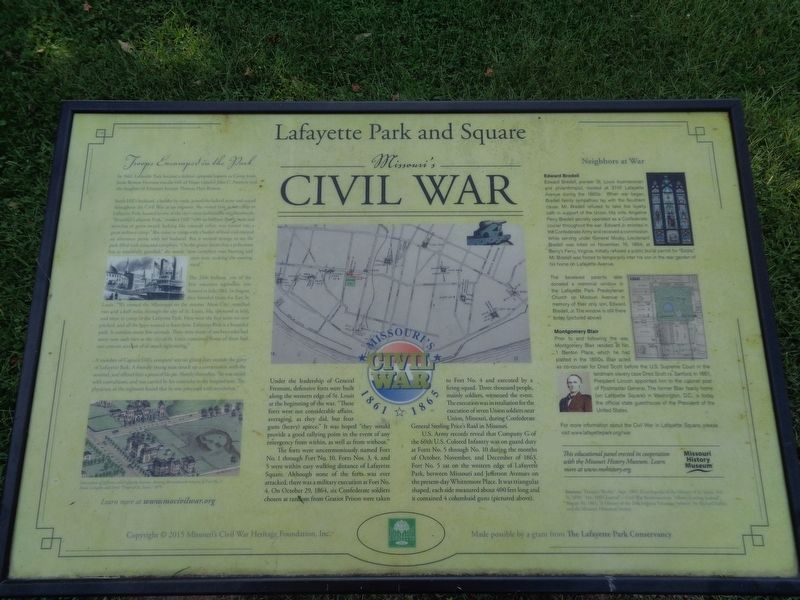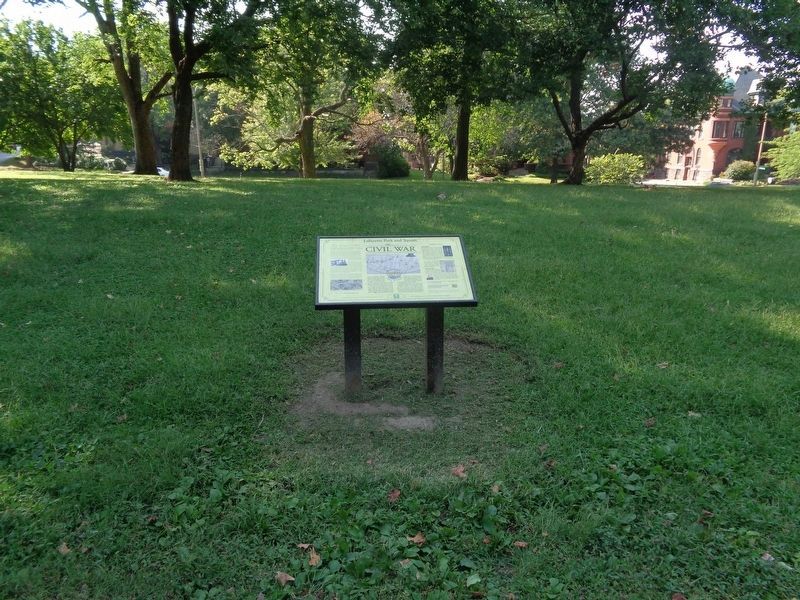Lafayette Square in St. Louis, Missouri — The American Midwest (Upper Plains)
Lafayette Park and Square
Missouri's Civil War
Troops Encamped in the Park
In 1861, Lafayette Park became a federal campsite known as Camp Jessie. Jessie Benton Fremont was the wife of Major General John C. Fremont and the daughter of Missouri Senator Thomas Hart Benton.
Sarah Hill's husband, a builder by trade, joined the federal army and served throughout the Civil War as an engineer. She visited him at his camp in Lafayette Park, located in one of the city's most fashionable neighborhoods. "Beautiful Lafayette Park," recalled Hill, "with its brilliant flower beds and stretches of green sward, looking like emerald velvet, was turned into a great military camp." She came to camp with a basket of food an enjoyed an afternoon picnic with her husband. But it seemed strange to see the park filled with tents and campfires. "On the grassy lawns that a policemen has so watchfully guarded," she noted, "now campfires were burning and men were cooking the evening meal."
The 24th Indiana, one of the first volunteer regiments, was formed in July, 1861. In August, they boarded trains for East St. Louis. "We crossed the Mississippi on the steamer 'Alton City', marched two and a half miles through the city of St. Louis, Mo. (pictured at left), and went to camp in the Lafayette Park. Here were the first tents we ever pitched, and all the boys wanted to learn how. Lafayette Park is a beautiful park. It contains many fine animals. There were many of our boys who had never seen such sites as the city of St. Louis contained. Some of them had sore eyes on account of so much sight-seeing."
A member of Captain Dill's company was on guard duty outside the gates of Lafayette Park. A friendly young man struck up a conversation with the sentinel, and offered him a piece of his pie. Shortly thereafter, "he was seized with convulsions, and was carried by his comrades to the hospital tent. The physician of the regiment found that he was poisoned with strychnine."
Under the leadership of General Fremont, defensive forts were built along the western edge of St. Louis at the beginning of the war. "These forts were not considerable affairs, averaging, as they did, but four guns (heavy) apiece." It was hoped "they would provide a good rallying point in the event of any emergency from within, as well as from without."
The forts were unceremoniously named Forts No. 1 through Fort No. 10. Fort Nos. 3, 4 & 5 were within easy walking distance of Lafayette Square. Although none of the forts was ever attacked, there was a military execution at Fort No. 4. On October 29, 1864, six Confederate soldiers chosen at random from Gratiot Prison were taken to Fort No. 4 and executed by a firing squad. Three thousand people,
mainly soldiers, witnessed the event. The execution was in retaliation for the execution of seven Union soldiers near Union, Missouri, during Confederate General Sterling Price's Raid in Missouri.
U.S. Army records reveal that Company G of the 60th U.S. Colored Infantry was on guard duty at Forts No. 5 through No. 10 during the months of October, November, and December of 1863. Fort No. 5 sat on the western edge of Lafayette Park, between Missouri and Jefferson Avenues on the present-day Whittemore Place. It was triangular shaped, each side measured about 400 feet long and it contained 4 columbiad guns (pictured above).
Neighbors at War
Edward Bredell
Edward Bredell, pioneer St. Louis businessman and philanthropist, resided at 2110 Lafayette Avenue during the 1860s. When war began, Bredell family sympathies lay with the Southern cause. Mr. Bredell refused to take the loyalty oath in support of the Union. His wife, Angeline Perry Bredell secretly operated as a Confederate courier throughout the war. Edward Jr. enlisted in the Confederate Army and received a commission. While serving under General Mosby, Lieutenant Bredell was killed on November 16, 1864, at Berry's Ferry, Virginia. Initially refused a public burial permit for "Eddie," Mr. Bredell was forced to temporarily inter his son in the rear garden of his home on Lafayette Avenue.
The bereaved parents later donated a memorial window in the Lafayette Park Presbyterian Church on Missouri Avenue in memory of their only son, Edward Bredell, Jr. The window is still there today. (pictured above)
Montgomery Blair
Prior to and following the war, Montgomery Blair resided at No. 1 Benton Place, which he had platted in the 1850s. Blair acted as co-counsel for Dred Scott before the U.S. Supreme Court in the landmark slavery case Dred Scott v. Sanford. In 1861, President Lincoln appointed him to the cabinet post of Postmaster General. The former Blair family home (on Lafayette Square) in Washington, D.C., is today the official state guesthouse of the President of the United States.
(caption) Intersection of Jefferson and Lafayette Avenues showing the earthwork remains of Fort No. 5
From Compton and Dry's "Pictorial St. Louis." 1875
For more information about the Civil War in Lafayette Square, please visit www.lafayettepark.org/war
This educational panel erected in cooperation with the Missouri History Museum. Learn more at www.mohistory.org.
Sources: "Harpers Weekly", Sept. 1861. Encyclopedia of the History of St. Louis, Vol. 11, 1899. "Mrs. Hill's Journal" - Civil War Reminisces: "Albany Evening Journal", August 30, 1861; "A History of the 24th Indiana Volunteers Infantry" by Richard Folfer; and the Missouri Historical Society.
Made possible by a grant from The Lafayette Park Conservancy
Learn more at www.mocivilwar.org
Erected 2015 by Missouri History Museum, the Lafayette Park Conservancy and Missouri's Civil War Heritage Foundation.
Topics and series. This historical marker is listed in these topic lists: Parks & Recreational Areas • War, US Civil. In addition, it is included in the Former U.S. Presidents: #16 Abraham Lincoln, and the Missouri’s Civil War series lists. A significant historical year for this entry is 1861.
Location. 38° 36.953′ N, 90° 13.074′ W. Marker is in St. Louis, Missouri. It is in Lafayette Square. Marker can be reached from the intersection of Madison Avenue and Whittmore Place, on the right when traveling north. Marker is located along a walking trail on the west side of Layette Park nearby the southwest entrance. Touch for map. Marker is at or near this postal address: 2023 Lafayette Avenue, Saint Louis MO 63104, United States of America. Touch for directions.
Other nearby markers. At least 8 other markers are within walking distance of this marker. 1876 Lafayette Park Music Pavilion (about 500 feet away, measured in a direct line); Senator Thomas Hart Benton, 1782-1858 (about 500 feet away); These Guns are from the British Man Of War (about 500 feet away); George Washington Statue (about 700 feet away); The Grotto Bridge (approx. 0.2 miles away); The Old Police Station / Park House in Lafayette Park (approx. 0.2 miles away); Norman Peter Gark (approx. 0.3 miles away); Welcome to Lafayette Square! (approx. 0.3 miles away). Touch for a list and map of all markers in St. Louis.
Also see . . .
1. Lafayette Park History. Lafayette Park Conservancy website entry (Submitted on September 24, 2019, by Jason Voigt of Glen Carbon, Illinois.)
2. Missouri Historical Society. Society website entry (Submitted on September 24, 2019.)
3. Missouri’s Civil War. Missouri’s Civil War Heritage Foundation website entry (Submitted on September 24, 2019.)
Credits. This page was last revised on January 30, 2023. It was originally submitted on September 24, 2019, by Jason Voigt of Glen Carbon, Illinois. This page has been viewed 302 times since then and 15 times this year. Photos: 1, 2. submitted on September 24, 2019, by Jason Voigt of Glen Carbon, Illinois. • Bernard Fisher was the editor who published this page.

